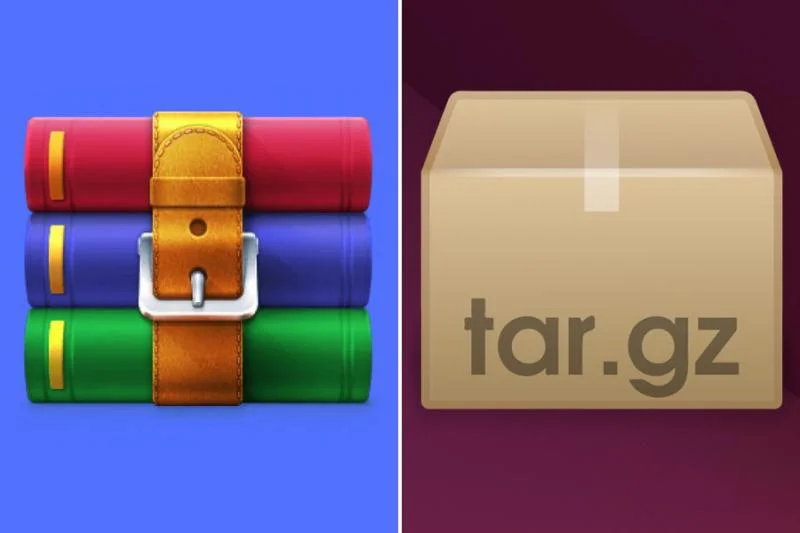The most important difference between TAR and RAR is how they store and work with files. While TAR focuses on archiving files so that they can be organised and shared, RAR focuses on both archiving and compression so that files can be stored and transmitted quickly. TAR (Tape Archive) is a file format and a Unix-based utility used to archive multiple files into a single file without compression, mainly to make it easier to store and share. RAR (Roshal Archive) is a proprietary file format and a compression tool that combines multiple files into a single archive and compresses the data, making the files much smaller.
What is TAR?
TAR, which stands for “Tape Archive,” is a file format and utility for Unix that is used to archive multiple files into a single file without compressing the data. TAR was first made for tape storage systems, but it has become a standard way to archive files on Unix and similar systems like Linux and macOS.
The main goal of TAR is to combine multiple files and directories into a single file, called a “tarball,” which makes it easier to store, share, and back up. TAR keeps the original files’ file structure, permissions, and other metadata so that when the files are extracted, they can be put back in their original state.
On Unix-based systems, TAR files usually end in “.tar,” They can be made and extracted with command-line utilities or graphical tools. Even though TAR doesn’t compress files by itself, it is often used with utilities that do, like gzip or bzip2, to make compressed archives with names like “.tar.gz” or “.tar.bz2.”
In short, TAR is a file format and utility for Unix that combines several files into a single file without compressing them. Its primary purpose is to organise, store, distribute, and back up files while keeping their original structure and metadata. It can be used with compression utilities to make storage and transfer faster and more efficient.
What is RAR?
Eugene Roshal made RAR, which stands for “Roshal Archive,” a proprietary file format and compression tool. It is used to archive and compress multiple files into a single archive, making the files smaller, so they take up less space and are easier to store and transmit. RAR files usually end in “.rar,” and software like WinRAR, RAR, and third-party apps that support the RAR format can be used to create and extract them.
RAR has a lot of benefits, like strong compression algorithms that often make archives smaller than other formats like ZIP. RAR also has features like password protection, error recovery, and the ability to make multi-volume archives, which break up large archives into smaller parts to make them easier to transfer or store.
The RAR format is very popular on Windows but is also available on macOS, Linux, and Android, among other platforms. But because RAR is a proprietary programme, its use may be limited in some situations because of licencing rules.
In short, RAR is a proprietary file format and compression tool used to archive and compress multiple files into a single, smaller archive. It has strong compression, password protection, error recovery, and support for multiple volumes, making it a popular choice for storing and moving files between platforms.
Difference Between TAR and RAR
While comparing TAR and RAR, it’s essential to focus on the critical distinctions between their file formats, features, compression ratios, and platform support. Because of these distinctions, file management, storage efficiency, and data transmission are all impacted.
File Formats
TAR (Tape Archive) and RAR (Roshal Archive) are archive formats used for storing and transmitting large amounts of data; TAR is based on Unix, while RAR is a proprietary archive format.
Functionalities
TAR’s primary use case is the uncompressed archiving of directories and files into a single file (a tarball). Combining archive functionality with compression, RAR greatly shrinks file sizes for easier archiving and transport.
Compression Capabilities
Although TAR alone does not compress files, it can be used with other compression programmes such as gzip or bzip2. But, RAR has compression algorithms built right in, which means reduced archive sizes on average.
Platform Support
TAR is the default archive format for Unix and Unix-like systems, such as Linux and macOS. Although RAR has found the most success in the Windows ecosystem, it is also compatible with macOS, Linux, and Android. Yet, as RAR is a proprietary format, there may be constraints on how and where it can be used due to licencing agreements.
In conclusion, TAR and RAR are distinctively different regarding file format, functionality, compression capacity, and platform support. Each format is optimised for specific circumstances and platform preferences; for example, TAR is best suited for archiving without compression, while RAR prioritises both archiving and compression for efficient storage and file transfer.







